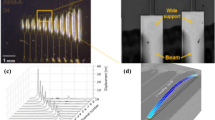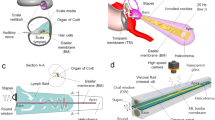Abstract
Two types of microfabricated acoustic transducers—the resonator array of isolated beams (RAIB) and the resonator array of coupled beams (RACB)—were built using MEMS technology. The frequency selectivity of the two types of transducers was qualitatively compared using the transfer functions measured with a scanning laser Doppler vibrometer (SLDV). Each RAIB beam operated as a band-pass filter in the proximity to the corresponding resonance frequency, thereby showing the frequency-selective feature of the basilar membrane (BM). However, the frequency selectivity of RACB was poor because the SiO2 membrane, which mechanically coupled the neighboring beams, suppressed the independent response of each beam. The influence of the mechanical coupling of the SiO2 membrane was simulated using lumped parametric models. Simulation results showed that the coupling stiffness of the SiO2 membrane may significantly undermine the frequency selectivity of the resonator array. The comparison of the frequency-selective performance revealed that RAIB is a better option than RACB for mimicking the tonotopy of BM.
Similar content being viewed by others
References
S. N. Graven and J. V. Browne, Auditory Development in the Fetus and Infant, Newborn and Infant Nursing Reviews, 8 (4) (2008) 187–193.
R. D. White and K. Grosh, Microengineered hydromechanical cochlear model, Proceedings of the National Academy of Sciences, 102 (5) (2005) 1296–1301.
F. Chen, H. I. Cohen, T. G. Bifano, J. Castle, J. Fortin, C. Kapusta, D. C. Mountain, A. Zosuls and A. E. Hubbard, A hydromechanical biomimetic cochlea: Experiments and models, The Journal of the Acoustical Society of America, 119 (1) (2006) 394–405.
M. J. Wittbrodt, C. R. Steele and S. Puria, Developing a Physical Model of the Human Cochlea Using Microfabrication Methods, Audiology and Neurotology, 11 (2) (2006) 104–112.
H. Shintaku, T. Nakagawa, D. Kitagawa, H. Tanujaya, S. Kawano and J. Ito, Development of piezoelectric acoustic sensor with frequency selectivity for artificial cochlea, Sensors and Actuators A: Physical, 158 (2) (2010) 183–192.
R. S. Chadwick, M. E. Fourney and P. Neiswander, Modes and waves in a cochlear model, Hearing Research, 2 (3–4) (1980) 475–483.
C. R. Steele and L. A. Taber, Comparison of WKB calculations and experimental results for three-dimensional cochlear models, The Journal of the Acoustical Society of America, 65 (4) (1979) 1007–1018.
W. J. Song, S. J. Bae, J. S. Park and W. D. Kim, Study on the tonotopy of polymer membranes mimicking the human basilar membrane, Conference on Implantable Auditory Prostheses, Pacific Grove, California, USA (2011).
W. J. Song, S. J. Bae and W. D. Kim, Characterization of Frequency Separation in Polymer Membranes Mimicking a Human Auditory System, Journal of the Korean Society for Nondestructive Testing, 31 (5) (2011) 516–521.
J.-H. Park, Y.-R. Oh, H.-S. Nam, Y.-J. Kim, T.-H. Kim and H.-Y. Kim, Residual strain measurement of piezoelectric multi-layers by spiral structure, Journal of Mechanical Science and Technology, 26 (7) (2012) 2139–2142.
F. Ebrahimi, A. Rastgoo and M. H. Kargarnovin, Analytical investigation on axisymmetric free vibrations of moderately thick circular functionally graded plate integrated with piezoelectric layers, Journal of Mechanical Science and Technology, 22 (6) (2008) 1058–1072.
S.-C. Woo and N. Goo, Prediction of actuating displacement in a piezoelectric composite actuator with a thin sandwiched PZT plate by a finite element simulation, Journal of Mechanical Science and Technology, 21 (3) (2007) 455–464.
J. Jang, S. Kim, D. J. Sly, S. J. O’Leary and H. Choi, MEMS piezoelectric artificial basilar membrane with passive frequency selectivity for short pulse width signal modulation, Sensors and Actuators A: Physical, 203 (2013) 6–10.
G. Szuladzinski, Formulas for mechanical and structural shock and impact, CRC Press (2009).
S. Kim, W. J. Song, J. Jang, J. H. Jang and H. Choi, Mechanical frequency selectivity of an artificial basilar membrane using a beam array with narrow supports, Journal of Micromechanics and Microengineering, 23 (9) (2013) 095018.
Author information
Authors and Affiliations
Corresponding author
Additional information
Recommended by Associate Editor Cheolung Cheong
These authors equally contributed to the first authorship.
Won Joon Song is currently a research scholar at the Institute for Fusion Technology for Production in Hanbat National University, Daejeon, Korea. He received his Ph.D. in mechanical engineering from the University of Cincinnati, OH, USA in 2010. He worked at BOSCH, Cheongwon, Korea from 1997 to 2003 as an R&D engineer. He served as a researcher at the Korea Institute of Machinery & Materials, Daejeon, Korea from 2010 to 2011. His research interests include auditory system modeling, cochlear mechanics, signal processing for artificial cochlea, occupational hearing loss assessment, combustion instability detection, and image processing of combustion flame.
Jongmoon Jang received his B.S. degree in Kyungpook National University in 2010. He currently is a Ph.D. candidate at the Daegu Gyeongbuk Institute of Science and Technology, Daegu, Korea. His research interests include BioMEMS, artificial cochlea, auditory prosthesis, flexible electrode array, piezoelectric microphone, and so on.
Sangwon Kim received his M.S. degree in the Department of Electrical Engineering and Computer Science of Kyungpook National University in 2011. He is currently a Ph.D. candidate of the Department of Robotics Engineering in the Daegu Gyeongbuk, Institute of Science and Technology, Daegu, Korea. His research interests include MEMS, sensors and actuators, and microrobots.
Hongsoo Choi received his B.S. degree in Mechanical Engineering from Yeungnam University in 2001 and his M.S. degree in 2003 and Ph.D. in 2007 from the School of Mechanical and Materials Engineering at Washington State University (WSU). He served as a postdoctoral scholar at WSU and UC Davis before joining the Korea Institute of Machinery and Materials as a Senior Researcher in 2009. He has been with the Daegu Gyeongbuk Institute of Science and Technology, Daegu, Korea since October 2010. His general research area is in BioMEMS, and his current research topics are micro/nano robot, artificial cochlea, piezoelectric micromachined ultrasonic transducers, and so on.
Rights and permissions
About this article
Cite this article
Song, W.J., Jang, J., Kim, S. et al. Influence of mechanical coupling by SiO2 membrane on the frequency selectivity of microfabricated beam arrays for artificial basilar membranes. J Mech Sci Technol 29, 963–971 (2015). https://doi.org/10.1007/s12206-015-0210-2
Received:
Revised:
Accepted:
Published:
Issue Date:
DOI: https://doi.org/10.1007/s12206-015-0210-2




